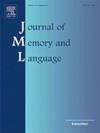The effect of similarity-based interference on bottom-up and top-down processing in verb-final languages: Evidence from Hindi
IF 3
1区 心理学
Q1 LINGUISTICS
引用次数: 0
Abstract
Sentence comprehension is known to be driven by both bottom-up integrative and top-down predictive processes. While integrative processes are known to be subject to working memory constraints, the impact of such constraints on top-down processing is less clear. Previous work has argued that verb-final languages provide rather weak and equivocal support for working memory constraints during bottom-up integrative processes. For these languages, top-down prediction has been shown to be more dominant. Here, we report a series of cloze completion and self-paced reading studies on a verb-final language, Hindi, to investigate if preverbal nouns with similar case marking lead to increased processing difficulty at the clause-final verb. Results show no effect of case similarity on reading times at the verb, implying that a solely bottom-up dependency completion process driven by memory constraints cannot explain these data. Another key finding is that verb prediction failures increase in configurations where preverbal nouns have similar case markings. Model evaluation suggests an explanation based on representation distortion – when the pre-verbal input is stored in memory, it probabilistically distorts to a non-veridical (or less accessible) memory representation, and this degraded representation of the context generates potentially faulty predictions of the upcoming verb. Together, the current work reveals two new insights: (i) Both top-down prediction and bottom-up integration assumptions are necessary to explain the reading data from verb-final languages, and (ii) top-down prediction is subject to working memory constraints due to representation distortion of prior sentence input stored in memory.
基于相似性的干扰对动词词尾语言自下而上和自上而下加工的影响:来自印地语的证据
句子理解是由自下而上的综合过程和自上而下的预测过程驱动的。虽然已知整合过程受工作记忆限制,但这种限制对自上而下处理的影响尚不清楚。先前的研究认为,动末语言对自下而上整合过程中的工作记忆约束提供了相当微弱和模棱两可的支持。对于这些语言,自上而下的预测已经被证明是更主要的。在这里,我们报告了一系列的完形填空和自定节奏阅读研究,以动词结尾语言印地语为研究对象,研究具有类似格标记的前语名词是否会导致从句结尾动词的处理难度增加。结果显示,动词的大小写相似度对阅读时间没有影响,这意味着仅仅由记忆约束驱动的自下而上的依赖完成过程不能解释这些数据。另一个重要的发现是,动词预测失败的情况在动词前名词有类似的大小写标记的情况下会增加。模型评估提出了一种基于表征扭曲的解释——当言语前输入存储在记忆中时,它很可能会扭曲成非真实的(或更难以访问的)记忆表征,而这种对上下文的退化表征会对即将到来的动词产生潜在的错误预测。综上所述,目前的研究揭示了两个新的见解:(1)自上而下的预测和自下而上的整合假设都是解释动末语言阅读数据的必要条件;(2)自上而下的预测受到工作记忆的约束,这是由于记忆中存储的先前句子输入的表征扭曲。
本文章由计算机程序翻译,如有差异,请以英文原文为准。
求助全文
约1分钟内获得全文
求助全文
来源期刊
CiteScore
8.70
自引率
14.00%
发文量
49
审稿时长
12.7 weeks
期刊介绍:
Articles in the Journal of Memory and Language contribute to the formulation of scientific issues and theories in the areas of memory, language comprehension and production, and cognitive processes. Special emphasis is given to research articles that provide new theoretical insights based on a carefully laid empirical foundation. The journal generally favors articles that provide multiple experiments. In addition, significant theoretical papers without new experimental findings may be published.
The Journal of Memory and Language is a valuable tool for cognitive scientists, including psychologists, linguists, and others interested in memory and learning, language, reading, and speech.
Research Areas include:
• Topics that illuminate aspects of memory or language processing
• Linguistics
• Neuropsychology.

 求助内容:
求助内容: 应助结果提醒方式:
应助结果提醒方式:


